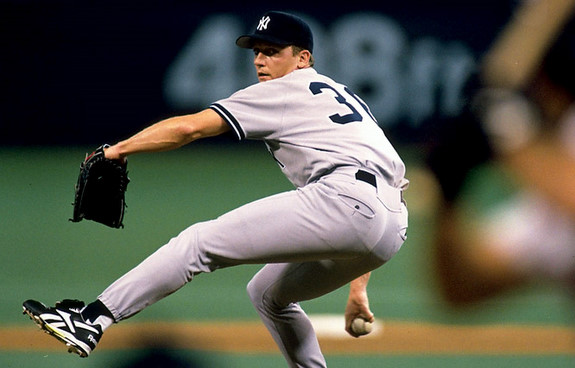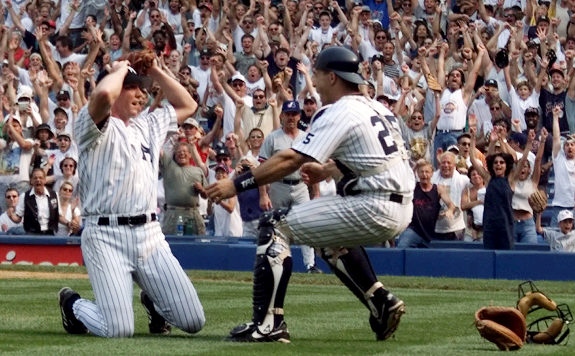
David Cone was no stranger to New York. The Yankees acquired the right-hander from the Blue Jays just before the 1995 trade deadline in exchange for three young pitchers — Jason Jarvis, Mike Gordon, and Marty Janzen — three years after his five-and-a-half year stint with the Mets came to an end. Cone, 32 at the time, was a hired gun. A hired gun that just so happened to be a former World Champion and the reigning AL Cy Young Award winner.
“What’s not to like?” said Don Mattingly after the trade. “I don’t even know the other three guys … It’s kind of like with John Wetteland. We got him for nothing.”
The Yankees were six-and-a-half games behind the division-leading Red Sox at the time of the trade, but they were on a six-game winning streak and had surged from ten-and-a-half back with an 11-4 stretch. Cone went 9-2 with a 3.82 ERA after the trade but the Yankees were unable to move past Boston in the standings. Instead, they were the first AL Wild Card team in baseball history. Cone got the ball in Game One of the ALDS against the Mariners, and led his team to a win by allowing four runs in eight innings. The decisive Game Five did not go as well, as Cone’s 147th and final pitch of the night was ball four to the light hitting Doug Strange, forcing in the tying run in the bottom of the eighth.
The Yankees went on to lose the game and series in extra innings, and Cone became a free agent after the season. Jimmy Key was slated to come back from injury, but they were still in a position to lose both Cone and Jack McDowell that offseason.
“It’s not my money, but I’d bring both of them back,” said manager Buck Showalter that September. “Where else are you going to find guys like that?” George Steinbrenner was a bit more business-like, saying “Cone’s not the only one out there.”
The Orioles, who finished eight games back of the Yankees in 1995, pursued Cone that offseason at owner Peter Angelos’ behest. The Mets also got involved at the last minute. Cone re-signed with the Yankees a few days before Christmas, after spending three days being courted at Steinbrenner’s hotel in Tampa. It was a three-year deal worth $19.5M, with two player options worth $5.5M each and a full no-trade clause. Baltimore offered three years and $17.7M, the Mets three years and $15M.
“George called me directly and offered me a no-trade clause and that proved to me that he really wanted to make a commitment,” said Cone after signing. “I don’t have to worry about being traded. He wanted me to be a Yankee and he proved it. That’s what I was looking for.”
Cone got the ball on Opening Day in 1996, and allowed just one run total in his first three starts. Something wasn’t right though. Cone was feeling numbness in his right fingers and then spasms in his forearm. The Yankees skipped one of his starts later in the month and sent him to the hospital. An angiogram ruled out a blood clot, and the doctors started pumping him full of blood thinners. Cone made a start in early-May and was brilliant, holding the high-powered White Sox to one unearned run in nine innings. Less than a week later, he was on operating table and having an aneurysm removed from his right shoulder.
“We picked this up early, that’s the good news,” said Dr. Stuart Hershon while GM Bob Watson added: “I don’t think it’s a life-threatening situation … They caught it early. It is correctable. It’s not career-threatening. Hopefully, he’ll be back this year. Hopefully. There’s no guarantee.”

There was no timetable for Cone’s return, and he wasn’t even allowed to lift his arm above his shoulder for the first seven weeks of his rehab. Baseball players are perpetual optimists when it comes to injuries, and Cone took that rehab milestone as a sign that he’d be back on the roster in August. Watson spent most of the summer looking for an extra starter just in case, though he ultimately settled on minor trades for relievers Billy Brewer and David Weathers.
Cone made his first rehab start on August 21st, then made his second a week later. A week after that, he was back on the active roster and back in the rotation. In his first start back — exactly four months after his last start — Cone threw seven no-hit innings against the Athletics before a pitch count forced him from the game. He made four more starts in September, finishing the season with a 7-2, 2.88 record. The Yankees went out of their way to give him some extra rest after the long layoff, which is why Cone got eight days off between Game One of the ALDS and Game Two of the ALCS, then eleven days off before Game Three of the World Series.
The Yankees had lost the first two games of the Fall Classic at home to the Braves, getting blown out in Game One and shutout in Game Two. Charged with keeping his team alive, Cone was matched up against Tom Glavine in Game Three and tossed six innings of one-run ball. The bullpen made it standup, and the Yankees were back in business.
”Given everything he has been through,” said first-year manager Joe Torre, ”I think this was the toughest start he’s ever had to make.”
Cone didn’t throw another pitch that year as the Yankees won the series in Game Six, but he was the scheduled starter for Game Seven if it had gotten that far. An offseason of rest after the most difficult season of his career was followed by yet another Opening Day start, the fourth of his career. He allowed four runs in the first game of the season, then allowed one run or less in nine of his next 14 starts. Cone finished the season with a 12-9 record but a 2.82 ERA, the victim of some spotty run support and a leaky bullpen. He didn’t make it out of the fourth inning in Game One of the ALDS as the Yankees were bounced by the Indians in five games.
One of the team’s three ace-caliber hurlers in 1998, Cone went 20-7, 3.55 as the Yankees won 114 regular season games. He set a new MLB record for years between 20-win seasons with ten. Cone won the ALDS clincher against the Rangers, the ALCS clincher against the Indians, and Game Three of the World Series against the Padres. He also finished fourth in the AL Cy Young voting, and leveraged his player option into a new one-year, $8M contract after the season.
”I always made it clear that my first choice was the Yankees,” said Cone. ”That’s where I want to be, where I want to end my career … Some people might second-guess me for not testing the free-agent waters, but I’m satisfied.”
Cone started 1999 in dominant fashion, pitching to a 13-4, 2.86 record through the first three months of his age 36 season. Steinbrenner and Yogi Berra had reconciled after a long feud, and Yogi Berra Day celebrated his return to Yankee Stadium on July 18th. Yogi caught the first pitch from Don Larsen, his batterymate for the only perfect game in World Series history, Game Five of 1956 World Series against the Dodgers. With Berra back at the Stadium and Larsen in the owner’s box, Cone threw the 16th perfect game in MLB history, sitting down all 27 Expos he faced. He endured a 33-minute rain delay in the third inning.

”I probably have a better chance of winning the lottery than this happening today,” said Cone after the game. ”What an honor. All the Yankee legends here. Don Larsen in the park. Yogi Berra Day. It makes you stop and think about the Yankee magic and the mystique of this ballpark.”
Cone was never the same after that game. It was the final complete game shutout of his career, and he pitched to a 6-8, 4.82 record the rest of the season. The Yankees won their second straight World Series that fall, though Cone didn’t appear in the ALDS before winning Game Two if the ALCS and Game Two of the World Series. Although the two sides reunited with a new contract after the season, the Yankees wouldn’t budge from a one-year offer. Cone eventually agreed to return for $12M.
There have been 608 instances of a pitcher throwing at least 100 innings in a single season for the Yankees, and none have ever posted a higher ERA than David Cone in 2000. No one is within half-a-run of him either. Cone tried new arm angles and new grips, the Yankees gave him extra rest and altered his schedule, but nothing worked. He allowed 31 runs in his final 26 innings and wasn’t allowed anywhere near the mound in the ALDS before throwing one garbage time inning in the ALCS.
Cone’s last hurrah in pinstripes came on October 25th, in Game Four of the World Series. Denny Neagle — who was acquired at the deadline because Cone’s performance had left the team short a starter — started the game. Mike Piazza had taken him deep in the third inning and was at the plate again with two outs in the fifth. Neagle had retired the first two men of the inning on fly balls, but Torre took the ball from him and brought in Cone for the matchup.
“Mike traditionally takes a strike, usually,” said Cone after the game. “I was a little careful with the first pitch, up and in. Then I threw a fastball away for a strike he took, then I threw two straight sliders. One he missed and one he fouled off … We tied him up. He popped it up.”
The Yankees won their fourth World Championship of the David Cone years the next night. He didn’t contribute much this time around, but he was allowed to tag along for the ride after doing so much for the team over the previous five years. It was no secret that the Yankees were going to move in a different direction after the season, but there were no hard feelings on either end.
”It was just a marvelous run,” said Cone. ”Nobody can take away from those years, regardless of what happens to me from here on out. My gut instinct is that I want to go somewhere where I’m needed, and there isn’t a great need for me with the Yankees.”
Cone signed a minor league contract with the Red Sox after the season, officially closing the book on his Yankees tenure. He went 64-40 with a 3.91 ERA in pinstripes, winning four titles and beating one aneurysm. The way the team was built meant he never had to be that undisputed ace, rather just be one of five starters and give his all every five days. Cone did that and more, the hired gun that became a rotation stalwart.
Leave a Reply
You must be logged in to post a comment.